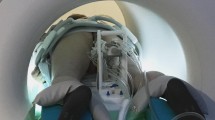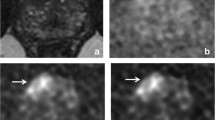Abstract
Magnetic resonance imaging (MRI) provides superior visualization of the prostate, its substructure, surrounding tissues, and, most important, focal lesions or cancer. The purpose of our canine study was to demonstrate the feasibility of a low-field (0.35 T) transperineal system that enables precise MR image guidance of prostate interventions. The canines were placed in the right lateral decubitus position. Template reconstruction, trajectory planning, contouring were based on T2-weighted FSE images. For image guidance and target confirmation, fast gradient spoiled-echo (FSPGR) sequence was used. MR compatible coaxial needles were manually inserted through the perineum to the base of the prostate. After satisfactory position was confirmed, brachytherapy catheters were placed through the coaxial needles. The mean deviation of the needle displacements was 2.9 mm with a median value of 2.7 mm. 97% of the errors were less than 4.0 mm. The needle placement accuracy was modelled by the Rayleigh distribution with a sigma value of 2.3 mm. Visual confirmation of needle placements was demonstrated on pathology tissue slices. The time needed for each step was: anaesthesia - 15 min, setup and positioning - 15 min, initial imaging - 15 min, template registration, projection - 15 min, contouring, trajectory planning, insertion of 12 needles - 60 min Based on our canine experiences our method seems to be a promising approach for performing feasible, accurate, reliable and high-quality prostate MR guidance within a reasonable time span.





Similar content being viewed by others
References
Ottó S, Kásler M (2005) A hazai és nemzetközi daganatos halálozási és megbetegedési mutatók alakulása. Magyar Onkológia 49:99–107
Jereczek-Fossa BA, Orecchia R (2007) Evidence-based radiation oncology: definitive, adjuvant and salvage radiotherapy for non-metastatic prostate cancer. Radiother Oncol 84:197–215
Morton G (2005) The emerging role of high-dose-rate brachytherapy for prostate cancer. Clin Oncol 17:219–227
Presti JC Jr (2000) Prostate cancer: assessment of risk using digital rectal examination, tumor grade, prostate-specific antigen, and systematic biopsy. Radiol Clin North Am 38:49–58
Futterer J (2007) MR imaging in the local staging of prostate cancer. Eur J Radiol 63:328–334
Morgan VA, Kyriazi S, Ashley SE et al (2007) Evaluation of the potential of diffusion-weighted imaging in prostate cancer detection. Acta Radiol 48:695–703
Alonzi R, Padhani AR, Allen C (2007) Dynamic contrast enhanced MRI in prostate cancer. Eur J Radiol 63:335–350
Mueller-Lisse UG, Scherr MK (2007) Proton MR spectroscopy of the prostate. Eur J Radiol 63:351–360
Pouliot J, Kim Y, Lessard E et al (2004) Inverse planning for HDR prostate brachytherapy used to boost dominant intraprostatic lesions defined by magnetic resonance spectroscopy imaging. Int J Radiat Oncol Biol Phys 59:1196–1207
Van Lin EN, Futterer JJ, Heymink SW et al (2006) IMRT boost dose planning on dominant intraprostatic lesions: gold marker-based three-dimensional fusion of CT with dynamic contrast-enhanced and 1H-spectroscopic MRI. Int J Radiat Oncol Biol Phys 65:291–303
Beyersdorff D, Winkel A, Hamm B et al (2005) MR imaging-guided prostate biopsy with a closed MR unit at 1.5 T: initial results. Radiology 234:576–581
D’Amico AV, Cormack R, Tempany CM et al (1998) Real-time magnetic resonance image-guided interstitial brachytherapy in the treatment of select patients with clinically localized prostate cancer. Int J Radiat Oncol Biol Phys 42:507–515
Fischer GS, Di Maio SP, Haker SJ et al (2006) A system for MR-guided prostate interventions. Proceedings of 1st IEEE/RASD-EMBS International Conference on Biomedical Robotics and Biomechatronics February 2006, 68–73
Di Maio SP, Pieper S, Chinzei K (2007) Robot-assisted needle placement in open MRI: system architecture, integration and validation. Comput Aided Surg 12:15–24
Fischer GS, DiMaio SP, Iordachita II et al (2007) Robotic assistant for transperineal prostate interventions in 3 T closed MRI. Med Image Comput Comput Assist Interv Int Conf Med Image Comput Comput Assist Interv 10:425–433
Engelhard K, Hollenbach HP, Kiefer B et al (2006) Prostate biopsy in the supine position in a standard 1.5-T scanner under real time MR-imaging control using a MR-compatible endorectal biopsy device. Eur Radiol 16:1237–1243
Menard C, Susil RC, Choyke P et al (2004) MRI-guided HDR prostate brachytherapy in standard 1.5 T scanner. Int J Radiat Oncol Biol Phys 59:1414–1423
Susil RC, Camphausen K, Choyke P et al (2004) System for prostate brachytherapy and biopsy in a standard 1.5 T MRI scanner. Magn Reson Med 52:683–687
Zangos S, Eichler K, Engelmann K et al (2005) MR-guided transgluteal biopsies with an open low-field system in patients with clinically suspected prostate cancer: technique and preliminary results. Eur Radiol 15:174–182
Zangos S, Hercog C, Eichler K (2007) MR-compatible assistance system for punction in a high-field system: device and feasibility of transgluteal biopsies of the prostate gland. Eur Radiol 17:1118–1124
Potter R, Haie-Meder C, Van Limbergen E et al (2005) Recommendations from gynaecological (GYN) GEC ESTRO working group (II): concepts and terms in 3D image-based treatment planning in cervix cancer brachytherapy—3D dose volume parameters and aspects of 3D image-based anatomy, radiation physics, radiobiology. Radiother Oncol 78:67–77
Author information
Authors and Affiliations
Corresponding author
Rights and permissions
About this article
Cite this article
Lakosi, F., Antal, G., Vandulek, C. et al. Technical Feasibility of Transperineal MR-Guided Prostate Interventions in a Low-Field Open MRI Unit: Canine Study. Pathol. Oncol. Res. 15, 315–322 (2009). https://doi.org/10.1007/s12253-008-9111-3
Received:
Accepted:
Published:
Issue Date:
DOI: https://doi.org/10.1007/s12253-008-9111-3




